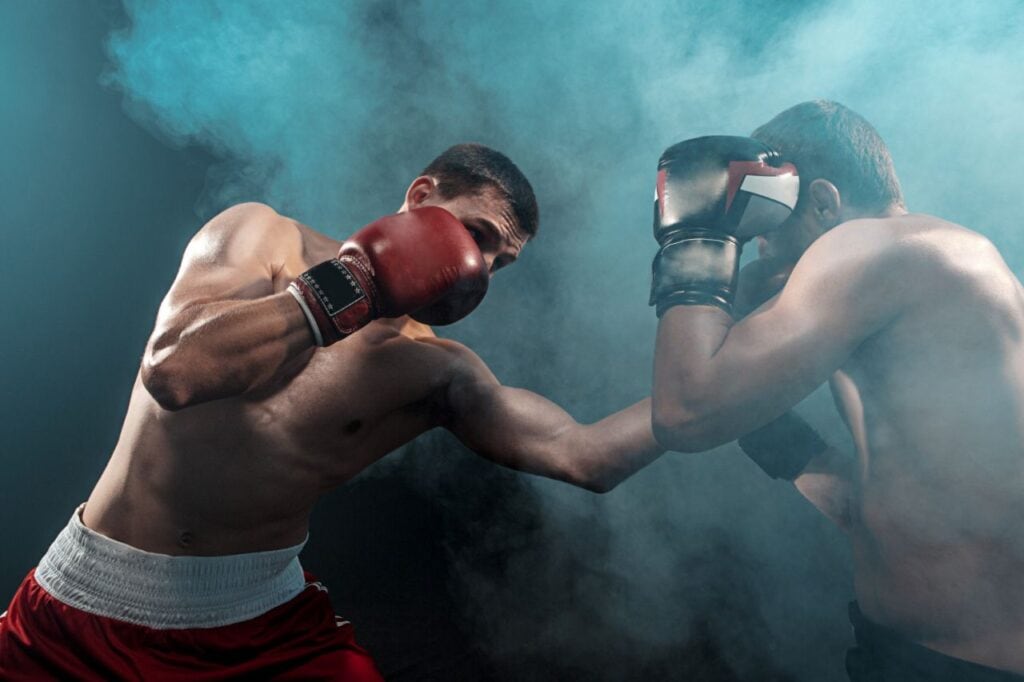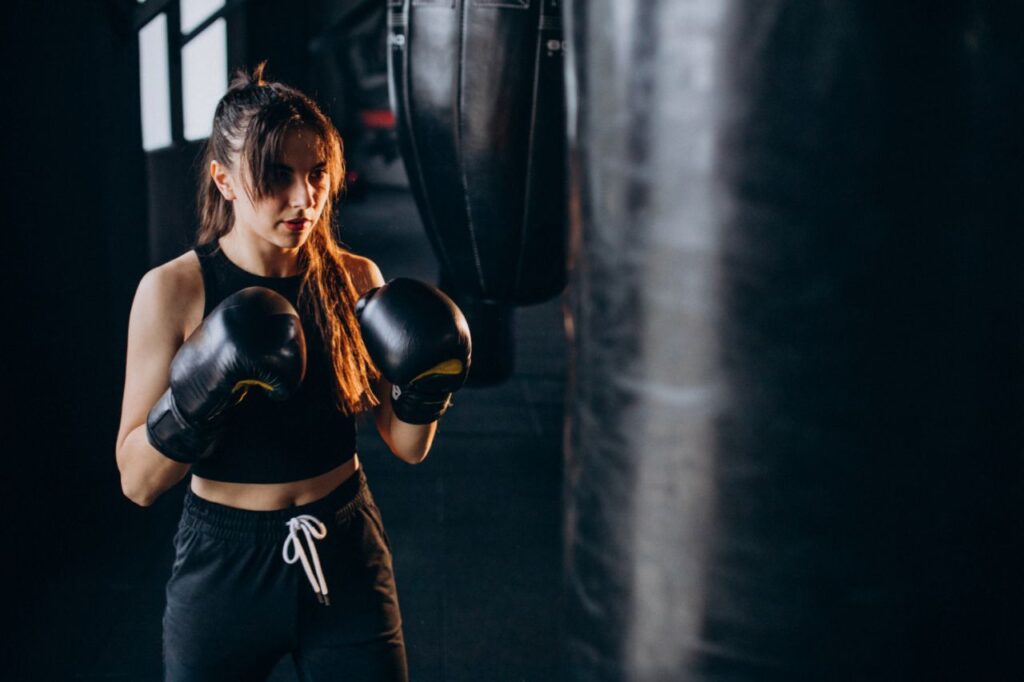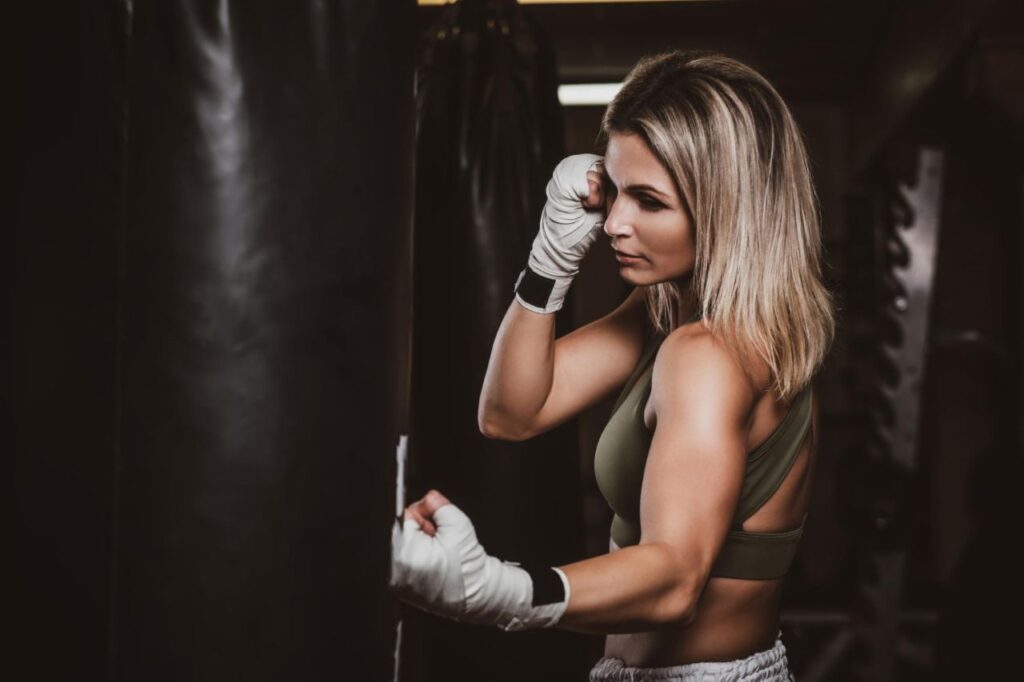Firstly, if you damage your muscle fibres in any shape or form, considering that you eat in a calorie surplus, you will build muscle. And yes, boxing training damages muscle fibres.
Right now, you might be thinking, alright, then I can build muscle with boxing, and you are tempted to start looking for a boxing gym. But, as some of you already know, many boxers don’t just do classic boxing routines (mitt drills, jumping rope, etc.). Some of them also do plyometric exercises some lift weights.
These strength training types are preferred for growing muscles by bodybuilders. So you must keep in mind that there can be various other strength regimens that boxers might do, and boxing might not be solely the reason for that incredible physique of a boxing superstar.
But hold on a minute or two as there are more things to consider. You might not reach your physique goals if you don’t know about it. When you think about boxing, what is the first thought that comes to mind?
Do you think of Rocky Balboa with a jab, cross, uppercut combo during an intense, nail-biting battle against Apollo Creed? Or maybe you think about some boxing legends like Iron Mike Tyson, Sugar Ray Leonard, or Joe Louis competing for the champ’s belt.
When you think about boxing, cardio and strength training in a boxing gym aren’t necessarily the first thoughts that come to mind, but they should be.
It’s not uncommon for any athlete of any kind to seek to have a muscular body.
This is no different in the case of boxers. However, it’s usually more complicated in their case since some of them can’t surpass a certain weight limit even to be eligible to compete.
Gone are the days when boxing is believed to only be for the fight-hungry men of the world. Today, boxing training and boxing exercises are a workout routine everyone can try, and they’re an incredible way to gain muscle, too.
So it doesn’t matter if you are the meanest and strongest bodybuilder on the block, or if you’re completely new to the exciting world of fitness--developing a training routine in boxing is an excellent way to exercise for all fitness levels because it constantly challenges you to grow and become the very best version of yourself.
Boxing: Do They Help You Gain Muscle?
Boxers are well known for their incredible physiques, which has led many people to incorporate boxing or ‘boxercise’ into their workout regimes to emulate or recreate the same or similar results for themselves.
But many people don’t have a very good understanding of boxing or the training side of it and see the boxers on fight night without grasping how boxers attain this form.
It’s well known that boxers can come in many different shapes and sizes, and there isn’t necessarily a perfect shape for boxing, as some boxers are very lean and muscular, while others are slightly less athletic.
Boxing, in general, does improve fitness immensely, however, and can build muscle and have other effects and benefits. In this guide, we’re going to look at if boxing builds muscle and how it does this and what role weight training plays in boxing training today.
What Muscles Do You Need In Boxing?
When you train for boxing, you shouldn’t only take into account your muscle groups and boxing stance and your cardiovascular system.
This system is made of muscles and organs like your heart and lungs that help you sustain the force and speed of your punches by pumping oxygen through your bloodstream to fuel your muscles.
Everybody knows that training a muscle is an advantage compared to not training it. If boxing were that simple, training the entire body would give you the ultimate physical advantage, right?
The problem is that nobody has the time to work out every single muscle. So many of your smaller muscles offer only a slight advantage, if at all.
With that in mind, having a strong cardiovascular system is important if you are looking to gain body weight in muscle. So why do you think TV and movies always show boxers working a jump rope or doing burpees?
Calves
The muscles located from the back of your ankles to the back of your knees are known as the calf muscles.
They help you press your toes into the ground and lift your heels. In boxing, you use them every time you throw a punch by initiating a step in the direction of the punch--footwork is important, and your calves play a big role when you step your left foot or right foot forward to throw a punch.
Legs
By “legs”, I’m referring specifically to the quads and the calf muscles. This should be ingrained into anybody ever wanting to learn how to do anything powerful with their body. ALL power comes from the ground, nowhere else!

Because your legs are connected to the ground, they are most responsible for pushing off the ground to generate power throughout your body. Your legs also happen to be the biggest muscles in your body, which is why all proper boxing punches are typically thrown with the legs pivoting and rotating.
Again, the legs generate the most power! Not the chest and not the triceps. If you look carefully at many of the most dynamic and complete punches or boxers in history, you will see that they have great legs more often than great arms or big chests.
Look very carefully at the typical boxer’s body, and you won’t find over-developed pecs or huge triceps. Marcos Maidana, Manny Pacquiao, Thomas Hearns, Julian Jackson, and Felix Trinidad are some names of guys that immediately come to mind.
These guys did not have big upper bodies, but they carried HUGE power in their fists. As dynamic a puncher as he was, even Mike Tyson was still more muscular at his legs than his arms!
Hips
Many people don’t think about their hips when it comes to boxing, but the hips are very important! The hips are essentially responsible for holding your lower body and legs together.
They also generate a massive amount of power by pivoting your entire body when needed. In addition, your hips play an important role in how well you are balanced.
Since your hips are very close to your body’s centre of gravity, having stronger hips means better control of your balance, one of the most important factors in boxing. Balance determines the efficiency and effectiveness of your defence, offence, movement, and overall fighting ability.
Abs
The abdominal muscles are a very powerful set of muscles that hold your whole body together. Every limb in your body generates a certain amount of power individually. Still, your abs allow you to combine the force generated by every limb into one total force.
Simply put, your abs allow you to connect the force generated by all your limbs into one powerful punch. Some bodybuilders bulk up to improve their body mass and strength.
Of course, you have the choice to either adopt the dirty bulk or clean bulk, as both have their benefits. However you build your mass, the abdominal muscles help you breathe and take frontal body shots.
Shoulders
After a good boxing workout, you will feel the burn in your shoulders. That is because all of the power that comes from your legs, hips, and core is filtered through the shoulder joints, meaning the shoulders are most important for punch endurance.
Typically, when boxers’ arms become too tired to hold up their fists to defend their head or even to throw a punch, it is usually because the shoulders are tired.
This is because the shoulder muscle sits on the edge of the arm and is relatively small but has the large task of holding up the entire arm. From a physics standpoint, it’s not hard to see why the shoulder tends to get tired so fast!
Aside from the boxing workout itself, weight training can help strengthen the shoulders to increase stamina in your actual boxing workout.
Back
The back also functions as a total body core muscle by holding your body together and combining the power generated by all your limbs. Another little known (BUT VERY IMPORTANT) fact is that the back helps a lot in punch recovery–which is how fast you can pull your hand back after a punch.
Many fighters are too busy building the front of their upper body through push-ups, push-ups and punching at the heavy bag, but very few focus on building up the back of the upper body like the rear shoulders and the back.
I will explain something very important when you spend all your time hitting the heavy bag. You may not realize that the heavy bag is bouncing your hand back at you in the recovery phase. By neglecting to work out your back and posterior shoulder muscles, you will have weaker punch recovery muscles.
The moment you start missing punches during a real fight, your arms will tire very quickly because your gloves become very heavy as you have to pull your punches back with your muscles instead of having them bounced back at you.
Arms
The arm muscles are all about power delivery because their primary function in boxing is to connect the power to the opponent.
We already know that the arms are not responsible for generating power - that’s what you have your legs for - however, the power that comes from your lower body that courses through your core to your shoulders is what drives your arms to throw each powerful punch.
The arms don’t generate power, they connect it, and that’s why it is so crucial to have fast arms rather than powerful arms in boxing.
Small Muscles
The neck is for punch resistance. You’ll see many fighters strengthening their neck so that their head doesn’t get whip-lashed and left in a more vulnerable angled position when it gets hit by punches.
The forearm muscles are for tightening your fist harder when you punch. A tighter fist means your hand will hit with a more solid punch. At the same time, a tighter fist means your hand is less likely to be injured since the bones don’t have much room to move around and get misaligned.
What Other Ways Can I Build Strength And Muscle For Boxing?
There are many ways to build strength and muscle for boxing, and weight training isn’t the only way.
Using various training types and techniques is important to maintain high motivation and prevent boredom which can massively affect an athlete’s mental state, reduce motivation performance and lead to plateaus and other unwanted outcomes for an athlete or trainee.
Incorporating other forms of exercise and training such as running, swimming, cycling, HIIT, and interval training are hugely beneficial to building muscle for boxing.
Many professional coaches use these different forms of exercise to maintain and assist in acquiring strength and muscle for boxers of various ability levels.
One Arm Push-ups
Push-ups help you balance your weight from your legs, shoulders, and arms.
They also add to building strength. It starts with you in a push-up position with toes and palms on the floor stretched straight, shoulders directly parallel above your palms and your body weight on your palms, toes, and shoulders.
Tighten your thighs, glutes, and abs. Lower your body down to the point when your chest almost touches the floor. Using the strength in your arms and shoulders, raise yourself back up to the original position.
Repeat. If you are a beginner, you can start with your knees on the floor and build from there. Move to the one-arm push-up as you build strength.
HIIT
High-intensity interval training (HIIT) is an excellent way to train at maximum heart rate for short periods. While it does involve lifting weights, it’s not a traditional bodybuilding routine with a very low number of reps.
The goal is to make each interval as tough as possible and only allow short breaks between sets. The time you spend doing the exercise is usually about 30 to 40 seconds, followed by just 10 to 20 seconds to rest and catch your breath. It’s a great way to get strong and lose some fat simultaneously.
One Leg Squats
Much like sit-ups, squats are also on the tougher side of the exercise spectrum. They are essential for building lower body strength. The exercise tones the thigh muscles as well as strengthen the hip muscles.
You can start by standing upright with your feet apart by a hip-width. Next, bend down into a sitting position at the hips. Pull your abs in and pull your shoulders back. You must get down as far as your thighs are directly parallel to the floor.
While bending down into a sitting position, raise your arms parallel to the floor as well. Keep your weight entirely on your heels and slowly stand back up. And repeat.
Callisthenics
These are gymnastic exercises that focus on body training and strength. It’s known to improve strength, posture, and body compositions, among other things.
One obvious advantage of these exercises is that you won’t need to use any major gym equipment to perform them. For example, there is no need for a squat rack or home gym.
All you need is your body weight. Numerous studies have shown that men who perform callisthenics manage to drastically lower body fat percentages while also increasing muscle without lifting any weights.
In Conclusion
So, will a boxing training workout help you to gain more muscle? The answer is: YES!
Boxing is an incredible full-body workout that can help you to build muscle in your legs, hips, core, arms, chest, and shoulders. It can also help with your strength, speed, hand-eye coordination, agility, endurance, and power.
In addition, boxing is also an excellent way to strengthen your cardiovascular system by keeping your heart rate up, which can give your heart and lungs a great workout, too. Some of the other exceptional benefits of boxing are weight loss, reduced stress, improved self-esteem, and improved posture.
There are many ways to get in shape, but it can sometimes be difficult to find an effective exercise regime that keeps you coming back for more. Another benefit of boxing is that workout classes are always changing to prevent boredom and keep you on your toes.
So, if you are looking for the ultimate way to get in shape to gain muscle all while having a little fun - boxing is for you!

FAQs
Does Boxing Bulk You Up?
A frequent question when it comes to boxing is, “does punching a bag build muscle?” Oh yes, it does. Just as they sound, power punches are more focused on the form and power behind a strike than speed and are the ultimate way to build lean muscle.
Can You Get Ripped From Boxing?
Professional boxers such as Floyd Mayweather prove boxing can get you ripped, but it doesn’t come easy. Boxing alone will help you be lean, but you also need muscle to get ripped. Strength training helps build muscle, while boxing uses cardio to help burn fat revealing the muscle underneath.
Is Boxing Better Than Gym?
While going to a gym remains the most popular option, boxing is not far away, especially among young men who fascinate the sport. Boxing is known to be a good cardio exercise. Boxing trains cardiovascular strength and endurance more effectively than most of the workouts available today.
Does Shadow Boxing Build Muscle?
Shadowboxing is a great exercise for muscle gain, especially for your shoulders, triceps, and biceps. It’s also super useful for toning your body’s different muscle groups. To put it short, when you throw punches in the air, contraction occurs, which contributes massively to muscle gain. However, you have to keep in mind that, although quite helpful, shadowboxing won’t help you add a substantial or noticeable amount of muscle mass.
Can I Use Boxing To Get In Shape?
Absolutely, and boxing is, in fact, one of the best ways to get in shape if you’re trying to obtain a lean and muscular physique as well as incredible flexibility and fitness. Boxing is intense, however, and many people struggle to keep up with these training sessions over a long period as they are intense. Eventually, however, you will get up to speed.
If you persevere, you will find yourself among some of the fittest athletes around, as boxing develops all aspects of physical fitness, from strength and endurance to flexibility, coordination, and technique.
- Find a gym. Boxing gyms aren't typically found in the yellow pages, but there are resources on the internet that can lead you in the right direction. ...
- Be sure the gym is within striking distance. ...
- Be open-minded. ...
- Choose your coach carefully. ...
- Do judge the gym by its cover.
So, can boxing be self-taught? Boxing can be self-taught but it's not the quickest and most effective way to become better at the sport because you aren't able to tap into the knowledge of a boxing coach who would be able to help you one to one.
Best Age to Start
Specialists in sports medicine believe that boxing classes are better to start from 9-10 years. Starting too early could result in putting the student off, as boxing is hard work and not always as fun as team sports, such as football or rugby.

